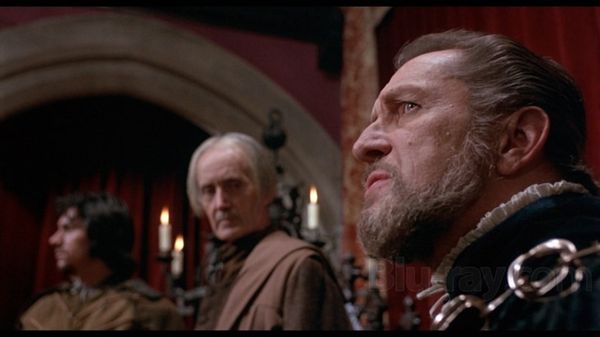Eye For Film >> Movies >> Cry Of The Banshee (1970) Film Review
Cry Of The Banshee
Reviewed by: Jennie Kermode

Everybody knows Witchfinder General. It’s widely considered to be among the greatest folk horror films ever made. But did you know that there’s another horror film out there starring Vincent Price as a witch hunter? Whilst it might be regarded as the poor relation, there’s enough style, energy and intrigue in this Medieval thriller for it to be worth checking out, especially if you’re a fan of the iconic actor.
Set a century earlier than its more famous cousin, this film centres on a clash between Price’s wealth, sadistic magistrate and Oona (Elisabeth Bergner), leader of a group of local people who resist his authority because of their allegiance to the old religions. In an early scene when Price is mixing work and pleasure, torturing hapless teenagers at a banquet, a howling sound is heard from somewhere outside and he is warned that he and everyone else present have been cursed, that they will soon die. Impatient with what he regards as ignorant superstitions, he sets out into the woods with a heavily armed posse, slaughtering several heathens who are dancing at a ritual sabbat. This, understandably, incurs Oona’s wrath, and she responds by summoning a spirit and commanding it to kill everyone in the magistrate’s family. Just to make the situation worse, it inhabits the body of family servant Roderick (Patrick Mower), with whom the magistrate’s daughter Maureen (Hilary Heath) is in love.
The script for this film went through major revisions not long before shooting began and it has an odd tone as a result. Director Gordon Hessler and Christopher Wicking (of Blood From The Mummy’s Tomb fame), whom he brought in to try and salvage it, had both spent time with modern witches and were unhappy about treating them as monsters, but the studio wanted a much more dogmatic approach. Bergner put her heart and soul into her character so that often she comes across as more sympathetic than the magistrate (allowing that both do monstrous things), yet the moral structure of the piece positions her simply as evil.. Hessler endeavours to work around this by styling it as a formal tragedy in which no-one can really escape, which is a bit hit and miss, though it does deliver a terrific final scene.
Caught in between the forces of law and disorder are the villagers who, as in most such films, exist to be exploited – especially if they are young, female and buxom. The original release of this film was heavily edited to keep the public safe from the corrupting influence of naked breasts, but even in that version, the brusque sexuality of the tale (consensual and otherwise) is impossible to conceal. There is also a good deal of violence, with whippings, beatings and a branding, which the villagers, as is their cinematic wont, cheer on with abandon. Look closely and you can spot a young Stephen Rea amongst them, in one of his first screen appearances. The film is also noticeable for a credit sequence animated by Terry Gilliam, commissioned before Monty Python’s Flying Circus brought him worldwide fame.
Handsome sets and costumes give the film a certain glamour that helps to obscure its weaknesses. Its central location, Grim’s Dyke House in Old Redding, is now a hotel, and the surrounding countryside strikes a good balance between civilised charm and occult potential. Most importantly, though, there is Price, and although he doesn’t get as much to do as in some of his other roles, he effortlessly commands attention, making every scene in which he appears his own. This was a prolific period in his career (he had recently finished Scream And Scream Again, also written by Wicking), but he always took his work seriously, and Cry Of The Banshee sees him on good form.
Reviewed on: 06 Nov 2021















